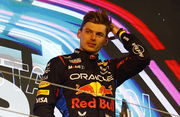Can You Drive a Formula One Car?

via Reuters
Formula One F1 – United States Grand Prix – Circuit of the Americas, Austin, Texas, U.S. – October 22, 2021 Mercedes’ Valtteri Bottas in the pits during practice REUTERS/Mike Blake
How many times have you seen a Formula One race and wondered, ‘I could do that too’? If you’re honest with yourself, the answer is almost every other race.
Every F1 fan dreams of getting in an F1 car and driving it, if not competing in it. And there’s nothing wrong with that. The sheer sounds of F1 engines and the capabilities of what that car can do are reason enough to make that prospect extremely enticing.
But unfortunately, more than 99% of us aren’t capable of driving an F1 car. And there are scientific reasons behind that sad reality.
ADVERTISEMENT
Article continues below this ad

via Reuters
Formula One F1 – United States Grand Prix – Circuit of the Americas, Austin, Texas, U.S. – October 24, 2021 General view of the fans in the grandstand during the race Pool via REUTERS/Darron Cummings
The physical side of Formula One
F1 drivers are athletes. They train and live according to the physical demands of their sport, and those are pretty high demands.
The most important reason for that is G Force. It’s a pretty well-known fact how gruelling and intense the training of an astronaut is. It takes years of physical training just for an astronaut to prepare to withstand the G Force of being launched into space, which is up to 3 Gs.
Trending
Red Bull Insider Delivers Bad News to Frederic Vasseur as He Reveals Big “Advantage” Over Ferrari

“Just Being Wheeled Around”: Adrian Newey Accuses Red Bull of ‘Not Involving’ Him in Strategic Calls After Decision to Leave

Pleasing GF Kelly Piquet’s Dad or Genuine Mistake- Max Verstappen Sparks Debate With Blunder During Ayrton Senna’s Tribute

Lando Norris’ Birthday Post Goes Wrong as He Exposes Max Verstappen’s Adventurous Side on Instagram, Sends Fans Into a Frenzy

Max Verstappen Makes Massive Blunder as Imola GP Stands Between Dutchman’s Favorite Activity

To put that number into perspective, on Earth, a normal person faces a G Force of 1 Gs. But an F1 driver experiences vertical accelerations of up to at least 3 Gs, multiple times a race, multiple times a week, for multiple times a year. Sometimes during high-speed corners, drives face G Force of up to 6 Gs.
The braking point is so late in @F1, it’s insane. The G Forces from hitting the brakes so hard actually make your eyes lose focus and vision go blurry 😳 Unreal feeling #JJxALO
Sound on 🔈🔈@McLarenF1 @alo_oficial @teamhendrick pic.twitter.com/PT5JRbvAZl
— Jimmie Johnson (@JimmieJohnson) November 26, 2018
Then there’s the force with which a driver decides the speed of the car, the brake and throttle pedals. A driver applies about 135 pounds of force to the brake pedal. As for turns, along with the G Force, a driver has to exert about 35 pounds of force for over 1,000 times a race.
And the physical demands are increased with the heat generated by the car and by the effort it takes to drive the car. This can lead to around 5% loss of body fluids, or sometimes, up to 4 kg of weight loss within a race.
The mental sharpness of a F1 driver
Driving an F1 car is an interactive activity. After all, it’s a competition against other drivers and adapting to the conditions which change by the second.
Drivers not only have to be constantly aware of their rivals, the track limits, the braking points, but they also have to manage different engine modes, brake configurations, aerodynamic adjustments while they’re racing.
Sounds like a lot of reactionary work, doesn’t it? According to a study, a Formula One driver has an average reaction time of 100 milliseconds. Most of us have an average reaction time of 300 milliseconds.
ADVERTISEMENT
Article continues below this ad
And these are just requirements that will make most of us fit enough to drive an F1 car.
These seemingly impossible requirements are just the entry criteria for becoming an F1 driver. Beyond that, it’s the racing talent and skill which enables the F1 drivers to make their way up from go-karting all the way to F1, which takes up most of the childhood, the teenage and in some cases, the adult life of a driver.
ADVERTISEMENT
Article continues below this ad
So, now you know why, out of almost 8 billion people in the world, there are only 20 Formula One drivers on the grid. And that’s probably why they call it, ‘the pinnacle of motorsports’.
Written by:



